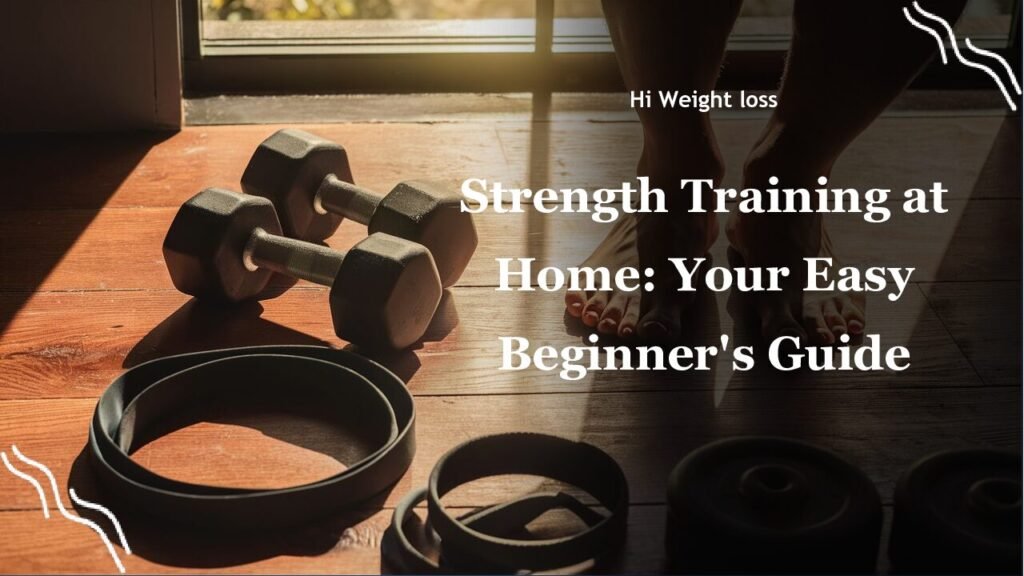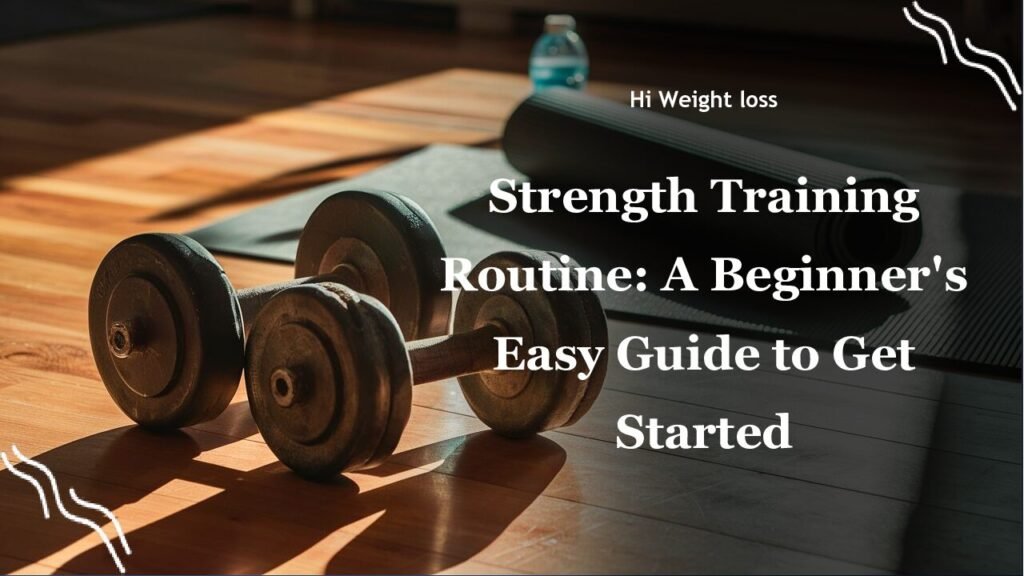“`
Are you feeling a bit lost when it comes to starting strength training? It’s understandable! Maybe you’re picturing complicated gym setups or heavy equipment, but what if I told you that you can build muscle and strength effectively right at home with very little equipment? This article will guide you through how to start strength training at home, using your body weight and a few inexpensive items, setting you on a path to a stronger you.
How to Do Strength Training at Home: A Beginner’s Guide
The Importance of Warming Up
Before you even think about lifting a weight or doing a single push-up, warming up is vital. It’s like prepping your car engine before a long drive; it gets everything ready and helps prevent injuries. Personally, I’ve learned the hard way about skipping warm-ups. Once, eager to get right into a workout, I jumped straight into heavy squats and ended up with a pulled hamstring that sidelined me for weeks!
A good warm-up gets your muscles warm and your heart rate up. A brisk 5-10 minute walk or light aerobic exercise should do the trick. This simple step makes a huge difference in how your body responds to the workout, so don’t skip it!
Best Bodyweight Exercises for Home Workouts
Bodyweight exercises are fantastic for beginners. You don’t need any fancy equipment, and they’re incredibly effective at building a solid foundation of strength. These exercises are my go-to when traveling or when I’m short on time. I’ve personally seen great results just from incorporating consistent bodyweight training, even when I can’t make it to the gym.
Let’s dive into a few of the most effective moves:
Push-ups:
Push-ups target your chest, shoulders, triceps, and core muscles. Start in a plank position, your palms directly under your shoulders. Lower your body by bending your elbows until your chest nearly touches the floor, then push back up. You can always modify them by doing push-ups on your knees if full ones are too tough at first. I have a friend who could barely do one push-up when we started working out together, but now, he can easily do 20 full push-ups!
Pull-ups:
Pull-ups work your shoulders, upper back, and biceps. If you have a pull-up bar at home, start with a dead hang, squeeze the bar, and pull yourself up until your chin is over the bar. These are tough, so don’t worry if you can’t do one at first. Many people find that using resistance bands to assist with pull-ups can be a great way to build up to doing them unassisted.
Squats:
Squats are incredible for working your major leg muscles. Stand with your feet slightly wider than shoulder-width apart, extend your arms straight with your palms facing down, and squat as low as you comfortably can, aiming to have your hips sink below your knees. I remember feeling pretty wobbly when I first started doing squats. It’s all part of the process. The key is to focus on good form before trying to increase the depth of the squat.
Lunges:
Lunges work the quads and glutes. Take a big step forward with one leg and lower your body until your front thigh is almost parallel to the floor. Alternate legs. Lunges can be tricky with balance at first, but with practice you’ll notice your strength and coordination improve. I’ve used lunges as a great way to challenge my balance and it has made a big difference in my workouts.
Using Basic Equipment for Strength Training
If you’re ready to add a bit of extra resistance to your training, you don’t need a lot of expensive gear. Simple tools like dumbbells and resistance bands can make a big difference. I’ve always found that these tools are super handy and very portable. When I was traveling and had limited gym options, resistance bands became my best friend.
Here are some great ways to use these:
Dumbbell Squats:
Holding dumbbells at your shoulders while doing squats adds extra challenge to the movement, which can really build leg strength. Remember to keep your weight in your heels while you are squatting.
Resistance Band Pull Apart:
This exercise strengthens your back, shoulders, and arms. Hold a resistance band tautly with both hands in front of you and pull it toward your chest by moving your arms outward. It’s surprisingly effective for targeting the often-neglected muscles in the upper back. My friend, a physical therapist, recommended resistance bands for these areas, and I noticed a real difference in how my back felt during and after training.

Setting Realistic Goals and Staying Consistent
Progress is key in strength training, but you need to set yourself up for success by aiming for gradual improvements, rather than massive leaps in the beginning. I’ve found that setting small, achievable goals makes it easier to stay motivated. Trying to do too much too soon can lead to burnout and injuries.
Aim for 2-3 strength training sessions a week, each lasting 20-30 minutes. The goal is consistency, not perfection. Over time, you can increase the intensity or duration of your workouts. It’s like a snowball effect; each session builds on the last, and before you know it, you’re much stronger than when you started.
Listening to Your Body and Avoiding Injury
One of the most important aspects of any training program is to listen to your body. If you feel pain, stop the exercise immediately. It’s important to use proper technique, and if a certain exercise bothers you, try reducing the weight or trying a modified version. Proper form is always more important than the amount of weight you’re lifting. Don’t be afraid to take breaks when you need them.
The Mayo Clinic emphasizes the importance of proper technique and avoiding pushing yourself too hard too early. I once pushed through some knee pain during squats and ended up needing physical therapy for weeks. I learned that respecting pain signals is absolutely crucial.
Example Strength Training Routine
To give you a better idea of what a typical home workout might look like, here’s a possible routine, keeping in mind that you can adapt it to your own fitness levels:
| Exercise | Sets | Reps | Rest |
|---|---|---|---|
| Push-ups (or modified on knees) | 3 | As many as possible (AMRAP) | 60 seconds |
| Squats | 3 | 10-12 | 60 seconds |
| Lunges (per leg) | 3 | 10-12 | 60 seconds |
| Dumbbell Squats (optional) | 3 | 8-10 | 60 seconds |
| Resistance Band Pull Apart | 3 | 12-15 | 60 seconds |
Remember that you may need more rest in the beginning as you gain strength, so don’t worry about taking that extra bit of time to recover between sets. As you grow stronger you can increase the reps and sets. Don’t forget to warm up before and cool down after the workout.
Conclusion
Starting strength training at home doesn’t have to be intimidating. You can effectively build muscle with just your body weight and a few simple items. Remember to always warm-up properly, then start with exercises like push-ups, squats, lunges, and pull-ups. Once you have a solid foundation you can add light dumbbells and resistance bands to increase the intensity of the workout. The key to getting stronger at home is not about how much weight you lift, but to set realistic goals and stay consistent with your training. Listen to your body, take breaks when you need them, and focus on proper technique. Like my friend who went from zero push-ups to twenty, you will be able to see great results and improve your fitness if you commit to this process!
So, are you ready to start building your strength at home? Share this with a friend, or leave a comment about your own experiences. Let’s encourage each other on this journey to a healthier, stronger life! Remember that strength training for beginners can be done in your own space.
FAQ
How often should I do strength training at home?
Aim for 2-3 times a week, with a rest day in between sessions. Remember, rest and recovery are just as important as the workouts themselves. Don’t feel the need to train more than that to see great results.
What if I can’t do a full push-up?
Start with push-ups on your knees or against a wall. As you get stronger, gradually move to a more challenging position, until you can do a full push-up from your toes. Healthline has some great articles on making modifications to your workouts to suit your level.
Do I need to buy a lot of equipment to do strength training at home?
No, you don’t! You can start with just bodyweight exercises. Dumbbells and resistance bands can add variety, but are not essential, especially when you’re first starting. It’s all about making small changes that fit with your routine and budget.
How long should my strength training sessions be?
Begin with 20-30 minute sessions. As you get fitter, you can increase the length of your training if you wish, or you can increase the intensity of your workouts by using more resistance or weights.
What are some good beginner-friendly resources?
There are many great online resources. Greatist has some excellent guides on how to start your fitness journey. Don’t be afraid to research and find what best suits you.
“`



